Abstract
The recent hype in online purchasing has skyrocketed the importance of the electronic commerce (e-commerce) industry. One of the core segments of this industry is business-to-consumer (B2C) where businesses use their websites to sell products and services directly to consumers. Thus, it must be taken care of that B2C websites are designed in a way which can build a trustworthy and long-term relationship between businesses and consumers. Thus, this study assesses and prioritizes factors for designing a successful B2C e-commerce website. The study employs multi-criteria decision making (MCDM), and to minimize any ambiguity and greyness in the decision-making, it integrates fuzzy and grey respectively with the Analytical Hierarchy Process (AHP) and Technique for Order of Preference by Similarity to Ideal Solution (TOPSIS) to form FAHP and TOPSIS-Grey. Initially, the study conducts a thorough literature survey to screen important factors reported in past studies. Five main factors and nineteen sub-factors were selected for further prioritization. Later, FAHP prioritized factors based on their importance. Finally, based on the FAHP results, TOPSIS-Grey ranked five alternatives (e-commerce websites). FAHP revealed “service quality” as the most successful website designing factor, while TOPSIS-Grey reported “Website-3” as the most successful website, having incorporated the factors required to design a successful website.
1. Introduction
The essence of marketing has changed with contemporary advancement and the development of the internet world, which have positively boosted the e-commerce trend [1]. E-commerce enables both consumers and companies to buy or sell products and offers varieties of services online, easily accessible quality products, and services that do not just save time but that also maximize profit or bargaining for both consumers and companies [2]. In this digital era, the e-commerce trend is increasing among people who want to buy and sell any products or services; and therefore, many researchers are interested to know in which way the success of e-commerce businesses inspires the consumers to buy and sell online. Researchers have determined that various important factors enhance the success of e-commerce businesses, and many companies or business owners are investing a gigantic amount of money on e-commerce websites. Many companies are trying hard to design a B2C e-commerce website that attracts their customers to buy and sell any product or service [3]. However, it is still very hard for many business owners to assess the success of B2C e-commerce websites, since various factors are involved. Moreover, the performance of B2C e-commerce depends upon the efficiency and success of the B2C e-commerce website. Therefore, it is important to assess and prioritize the B2C e-commerce websites since this is very vital for both customers and companies.
Moreover, the continuous development in e-commerce has expanded into five known categories: Business to Consumer (B2C), Business to Business (B2B), Consumer to Business (C2B), Consumer to Consumer (C2C), and Business-to-Government (B2G) [4]. Amazon is the best example of a B2C commerce which sells products and services to final consumers. Alibaba, a top-rated online platform, is an example of B2B commerce where companies deal only with companies. Upwork, formally known as Elance, is a C2B commerce where consumers post their project online and let companies bid for these projects. After that, consumers decide to select companies. A perfect example of C2C is eBay, where consumers find consumers to sell their products online. Upwork is an example of B2G, where businesses deal with the government and the government agencies to offer information, products, and services through online marketing. Business-to-Government (B2G) e-commerce offers competition among different companies to bid for government projects, products, and services that can later be acquired by the government from their organizations.
These are the popular categories of e-commerce; however, B2C happens to be a dominant form of e-commerce in today’s online market matching with traditionally giant brink-and-mortar outlets. The currently most famous and top B2C e-commerce companies are Amazon, Alibaba, Walmart, Otto, JD.com, Priceline, eBay, and Rakuten [5]. These are the leading and most influential B2C e-commerce companies in the world. The popularity of B2C opens the business door for online companies to enjoy the high volume of sales every year. However, the rapid success and development of internet-based commerce also cause the sensitivity and vulnerability of consumers’ privacy on B2C online platforms [6]. Therefore, this study focuses on the reliability of B2C online platforms to provide better services to final consumers.
Many marketing researchers apply multiple criteria decision making (MCDM) and several other approaches to B2C e-commerce related problems, such as Analytical Network Process (ANP) [7], Analytical Hierarchy Process (AHP) [8], Decision-Making Trial and Evaluation Laboratory (DEMATEL) [9], Technique for Order Performance by Similarity to Ideal Solution (TOPSIS) [10], Data Envelopment Analysis (DEA) [11], Grey Relational Analysis (GRA) [7], Preference Ranking Organisation METHod for Enrichment Evaluation (PROMETHEE) [12], and Vlse Kriterijumska Optimizacija Kompromisno Resenje (VIKOR) [13]. The PROMETHEE for Sustainability Assessment (PROSA) is also a very suitable method for determining any multi-faceted decision problem [14]. However, prior studies mainly focused on B2C e-commerce assessment; practical limitations should also be paid equal attention to. First, the evaluation of the B2C e-commerce platform primarily advances in terms of service quality [15]. Many marketing researchers believe that the level of the perceived service cannot just define the service quality, and they described the difference between the level of the perceived service and the level of the expected service [16,17].
Therefore, this study further contributes to the literature by integrating the Fuzzy AHP and TOPSIS-Grey methodology to assess the B2C e-commerce critical factors for designing a website. To the best of the author’s knowledge, there is no such study conducted to evaluate B2C e-commerce factors using Fuzzy AHP and TOPSIS-Grey methodology. The Fuzzy AHP method deals with the hierarchical structure between main-factors (criteria) and sub-factors (sub-criteria). The fuzzy set theory was adopted to enhance the incapability of deterministic evaluation information in modeling the real problem. Furthermore, the TOPSIS-Grey method was utilized to determine the best-suited B2C e-commerce website in China. The proposed decision method is based on symmetric principal targets to evaluate the usability of the consumer information about the perceived reputation of the quality service of the B2C e-commerce platform. Additionally, practical applicability regarding making a decision under a complicated situation is a specific strength of this technique while assessing the B2C e-commerce platform.
This research paper is formatted as follows. Section 2 highlights the literature review on MCDM. Section 3 discusses the proposed methods of this paper. Section 4 broadens the understanding of the proposed method through results and a discussion. Finally, Section 5 sums up the paper with a conclusion, implications, and future directions.
2. Literature Review
Over the last twenty years, the usage of the internet has largely increased. In this era of modernization, the internet has become a key channel for powerful communication mechanisms to facilitate the processing of business and trade transactions effectively. Nowadays, business dealings mostly rely on e-commerce channels because they provide a fast and reliable quality service to the customer. The term e-commerce is defined as any form of business transaction in which the parties contact each other electronically rather than exchanging physically [18]. E-commerce refers to business activities containing manufacturers, consumers, intermediaries, and service providers using the internet [19]. E-commerce activities reduce the costs of business transactions and save time, which makes business efficient and practicable.
The B2C e-commerce evaluation is a crucial problem where complex trajectories are involved in making a final decision. Since the decision problems are complex, it is important to structure the problems to avoid any difficulty in accomplishing the task. Therefore, in this context, the MCDM approaches are considered significant to minimize the decision problem to some extent. The MCDM methods help decision-makers to assess and rank the alternative based on the evaluation of several criteria of a decision problem.
2.1. Application of MCDM Approaches in B2C E-Commerce Evaluation
The MCDM are widely used techniques in evaluating the B2C e-commerce critical factors for the successful designing of a website. Mardani et al. [20] investigated the MCDM method used in various decision problem studies. Here, Table 1 displays the MCDM methods used in previous studies related to the development of B2C e-commerce websites.

Table 1.
Multi-criteria studies based on the assessment of B2C e-commerce websites.
It is identified in the literature that numerous studies relate to the evaluation of B2C e-commerce websites by determining the critical factors. These studies used numerous MCDM methods to assess the decision problem. This research further contributes to the state-of-the-art methods by developing an integrated decision framework comprising of Fuzzy AHP and TOPSIS-Grey methodology to assess the B2C e-commerce websites in the context of China. The Fuzzy AHP is widely recognized as one of the effective techniques for the weight allocation of criteria and sub-criteria. It has the advantage of simplicity and ease of use, but it is not sufficient to take into account the uncertainty related to the mapping of one’s perception to a number. Moreover, the qualitative assessment of respondent judgement is vague, and it is not reasonable to represent it in terms of precise numbers. As such, in order to address this apprehension, the TOPSIS-Grey concept was proposed in this study to compensate for the insufficiency of Fuzzy AHP regarding the uncertainty problem, to identify the ideal alternative solutions.
2.2. Proposed B2C E-Commerce Factors
This research identifies and evaluates several key factors for the designing of a B2C e-commerce website. These factors are very important and are considered as a supporting mechanism for evaluating a feasible e-commerce website. In the present study, a detailed literature review was analyzed to determine the most feasible factors for a B2C e-commerce website. Thus, in the study, five factors and 19 sub-factors were identified through the set of the literature review. These main e-commerce factors are design (D), information (I), service quality (Q), security/privacy (S), and customer support and service (C). Table 2 presents the B2C e-commerce website factors.

Table 2.
B2C e-commerce website factors, sub-factors, and their description.
It is observed that MCDM methods are comprehensively utilized in analyzing the critical factors for evaluating the successful implementation of e-commerce websites. The MCDM methods have been considered as very effective and efficient in solving multi-faceted decision problems. To the best of our knowledge, this is the very first study that analyzes the B2C e-commerce factors of websites using the Fuzzy AHP and TOPSIS-Grey methodology in the context of China.
3. Research Methodology
Many decision problems are too multifaceted to be solved quantitatively. In such cases, the use of MCDM proves to be the best choice due to their ability to deal with the multidimensionality of decision-making problems [39,40]. However, while solving such problems qualitatively, people tend to use imprecise knowledge rather than precise knowledge. Therefore, MCDM methods are integrated with fuzzy set theory and grey theory to minimize uncertainty and greyness in people’s feedback. So, this study combines Fuzzy AHP, TOPSIS and Grey theory to rank e-commerce websites. We firstly define Fuzzy AHP, TOPSIS, and Grey theory individually and then introduce and present the procedure of the proposed Fuzzy AHP and TOPSIS-Grey methodology.
3.1. Fuzzy AHP Method
Fuzzy AHP applies for triangular fuzzy numbers (TFNs) to construct a pairwise matrix of decision-makers’ preference [41,42]. This study has followed [43] to apply FAHP. The steps of FAHP are given as:
Step 1: The initial step of FAHP transforms the problem into a hierarchal structure.
Step 2: Construct a pairwise matrix of attributes using TFNs provided in Table 3.

Table 3.
Fuzzy Scale using TFNs.
TFNs define relative significance values to incorporate human judgement. For an inverse comparison, reciprocal values are assigned, for example, , where denotes the significance of element to element. Subsequently, a fuzzy matrix can be given as:
where , if ; and or if .
Step 3: The third step aggregates the judgement of individuals and then generates priority vectors of the group. Two common aggregation approaches are provided in the literature. The first one involves aggregating individual priorities (AIP), and the second one involves aggregating individual judgements (AIJ). AIP is proficient for aggregating when group members unite for decision while AIJ is applicable when group members make a decision individually. This study applies AIJ because it addresses experts’ judgements earlier and avoids re-evaluation if inconsistencies arise while ranking the alternatives. Subsequently, we express the TFN score assigned by expert on component as , where ) and (. The aggregate judgement , where ( of a group is given by . The crisp value of TFN , where (, is computed by .
Step 4: The consistency index given in Equation (2) is used to check the consistency of the matrix:
where denotes the matrix’s size.
The consistency ratio provided in Equation (3) has been applied to check the consistency of judgement:
where represents the random index, whose values are given in Table 4. Only if the value of is less than 0.1 is the judgment matrix considered as consistent.

Table 4.
.
3.2. TOPSIS Method
TOPSIS is one of the most famous approaches of the MCDM techniques [41]. The method was proposed by Hwang and Yoon for the first time in 1981 [44]. According to the TOPSIS method, the optimal solution point is nearest to the “positive ideal solution” and farthest from the “negative ideal solution.” The positive ideal solution is the one that maximizes (minimizes) benefit criteria (cost criteria). Conversely, the negative ideal solution minimizes (maximizes) benefit criteria (cost criteria) [45,46]. The following are the seven steps involved in a typical procedure of the TOPSIS method:
Step 1: Construct a decision matrix.
Let us define a decision matrix as:
where the decision matrix has alternatives and criteria; evaluates the th alternative with respect to the th criteria.
Step 2: Normalize the decision matrix using Equation (5) as given below:
Step 3: Transform the normalized matrix into a weighted normalized matrix using Equation (6):
where is the criteria weight of the th criteria, and the sum of weights of all the criteria is equal to 1.
Step 4: Find out the ideal positive solution ( and ideal negative solution ( using Equations (7) and (8), respectively:
where denotes the benefit-type criteria (larger the better), while represents the cost-type criteria (smaller the better).
Step 5: Calculate the distance between the optimal point and ideal positive and ideal negative solutions using the Euclidean distance [47]. For a benefit-type criterion, the distance can be calculated using Equation (9), and for a cost-type criterion, Equation (10) can be used to find the distance:
Step 6: Compute the relative closeness () to the ideal solution using Equation (11):
Step 7: Rank the alternatives based on the score; the larger score of indicates the better alternative.
3.3. Grey Theory
The Grey theory is a mathematical theory proposed by Professor Deng in 1982. The theory was founded on the concept of a grey set. The theory introduces a grey number that can effectively solve problems that involve uncertainty and have insufficient or incomplete data [48]. Let us define a grey number , where , and are real numbers showing lower and upper limits, respectively. If the values of both , and are known, then the number is called a white number, which translates the availability of complete information. In the case where both , and are unknown, then the number is called a black number, which means the information is not meaningful. A grey number means that the exact value of a number is unknown; however, it is certain that the value is not lower than and not greater than . We can define the value of a grey number as . Mathematical operations on grey numbers can be done as below [49]:
Since grey numbers are a special case of fuzzy numbers, we can therefore transform TFNs and into the grey numbers and using the Euclidean distance between the grey numbers (), as given in Equation (16):
3.4. Proposed Integrated Fuzzy AHP and TOPSIS-Grey Methodology
The proposed integrated method combines two widely used MCDM techniques, i.e., AHP and TOPSIS, with fuzzy theory and grey theory to form the integrated Fuzzy AHP and TOPSIS-Grey method. The method starts by developing the hierarchal structure of the problem and then computing weights of the criteria. Later, TOPSIS-Grey is applied to rank the alternatives. Figure 1 presents the structure of how the model is executed.
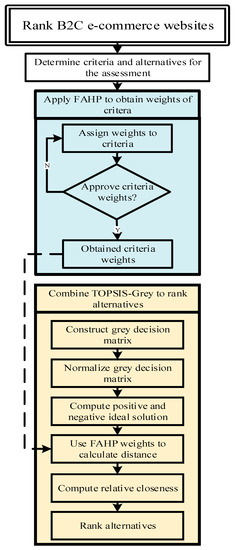
Figure 1.
Schematic of the model formulation.
The following are the steps involved in ranking the alternatives using the Fuzzy AHP and TOPSIS-Grey approach:
Step 1: Develop the hierarchal structure of the problem by defining the goal, criteria, and alternatives to be evaluated.
Step 2: Compute the weights of criteria using Fuzzy AHP.
Step 3: Rate alternatives with respect to each criterion using the linguistic values given in Table 5.

Table 5.
Grey scale for rating alternatives with respect to criteria.
Step 4: Define the TOPSIS-Grey decision matrix as:
where represents a grey evaluation of the th alternative with respect to the th criteria by the decision-maker ; ] represents an evaluation of the th alternative by the th decision-maker.
Step 5: Normalize using Equation (18) (for the benefit-type criteria) and Equation (19) (for the cost-type criteria):
where denotes the interval’s lower value, and denotes the interval’s upper value.
Step 6: Compute a positive ideal alternative and a negative ideal alternative using Equations (20) and (21), respectively:
where denotes the benefit-type criteria (larger the better), while represents the cost-type criteria (smaller the better).
Step 7: Compute the alternatives’ positive ideal solution distance and negative ideal solution distance using Equations (22) and (23), respectively:
In Equations (22) and (23), (Euclidean distance function), and is the weight of the th criteria determined using Fuzzy AHP.
Step 8: Obtain the relative closeness () to the ideal solution using Equation (24):
Step 9: Rank the alternatives based on the score; the larger score of indicates the better alternative.
The steps of the above proposed Fuzzy AHP and TOPSIS-Grey methods would provide meaningful results to determine this decision problem.
4. Results and Discussion
In the present research, the Fuzzy AHP and TOPSIS-Grey methodology has been presented in a real-life case study. This integrated decision framework outlines a feasible and systemic approach for government and managers toward assessing and prioritizing the B2C e-commerce factors for designing a website. The case analysis of the study is shown in the following sub-section.
4.1. Case Analysis
This case study is from the B2C e-commerce shopping websites in China, which sell various products to the consumers. These companies operate their e-commerce websites and simultaneously plan to introduce B2C e-commerce websites in order to expand their market. Meanwhile, each B2C e-commerce business has different requirements, processes, and related costs. Therefore, it is significant to understand the role of B2C e-commerce to implement the website in the electronic market successfully. In this study, five B2C e-commerce websites were evaluated and ranked based on the identified factors and sub-factors. The information or names of the websites are not exposed, and we define them as Website-1, Website-2, Website-3, Website-4, and Website-5. To evaluate feasible websites, the present study implemented the Fuzzy AHP and TOPSIS-Grey approach with respect to the proposed B2C e-commerce factors.
4.2. Fuzzy AHP Results
The results of this study are divided into two parts. The first part presents the result and analysis of Fuzzy AHP, which is used to assign the weights of main-factors and sub-factors. The second part presents the ranking of alternatives computed by applying TOPSIS-Grey. The study involved 15 experts to rate each factor (criteria) and sub-factor (sub-criteria) using linguistic values which were converted into crisp values. Initially, Fuzzy AHP transformed the problem into a hierarchal structure that is provided in Figure 2.
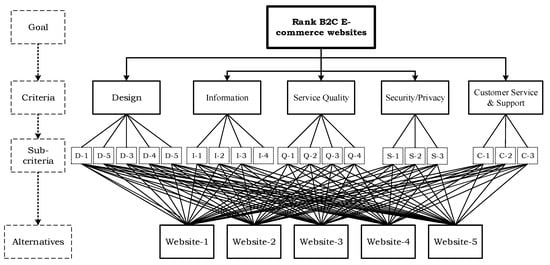
Figure 2.
The hierarchical structure of the decision problem.
4.3. Main-Factors Weights
After transforming the problem into a hierarchal structure, the Fuzzy AHP computed the weight of the main factor (Design, Information, Service Quality, Security/Privacy, and Customer Support & Services). The pairwise matrix of the main factor is given in the Appendix A section. By solving the pairwise matrix, we obtained the main factor weights, which are presented in Figure 3. It can be seen that the Service Quality criterion was rated as the most critical successful factor in designing a B2C e-commerce website by receiving a 25.8% weight. The Security/Privacy criterion obtained the second-highest weight of 24.5%, which is nearly 5% lower than the weight of the Service Quality criterion. Thus, it can be said that both factors hold significant importance and must be given due consideration while designing the website. The third criterion in the row is Design, which received a 17.9% weight, followed respectively by the Information criterion (16.4%) and the Customer Service & Support criterion (15.4%).
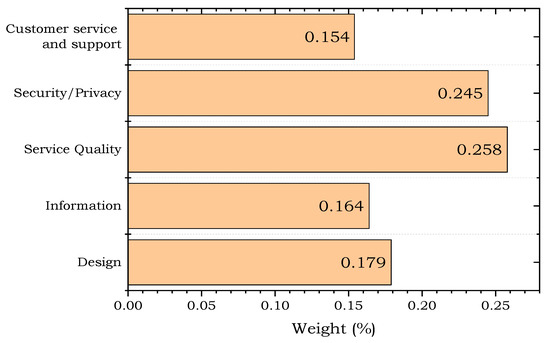
Figure 3.
The B2C e-commerce factor (criteria) results with respect to the goal.
4.4. Weights of Sub-Factors (Design)
After computing the main factor’s weights, the Fuzzy AHP computed the weights of sub-factors with respect to the main factor using similar steps to those used for calculating the weights of the main factor. A total of five pairwise matrices were constructed (one for each main criteria), which are given in Appendix A (Table A2, Table A3, Table A4, Table A5 and Table A6). By solving these matrices, we get the sub-factor weights with respect to their respective main factor. Figure 4 presents the weights of sub-factors with respect to the Design criterion. Under this criterion, the sub-criterion Attractiveness (D-1) received the highest weights of 22.8%, followed respectively by Speed (D-4) 22.1%, Content (D-3) 22.4%, Easy Navigation (D-2) 17.4%, and Mobile-friendly (D-5) 16.3%.
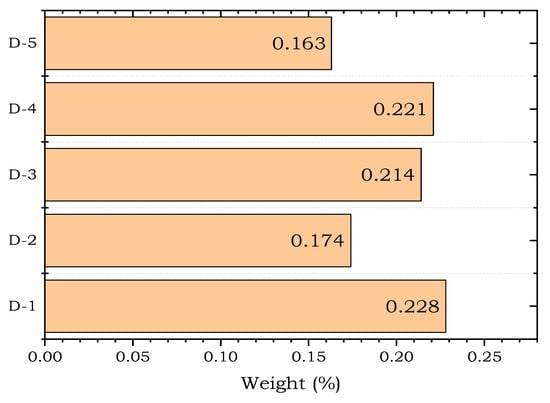
Figure 4.
The sub-factor results with respect to the design.
4.5. Weights of Sub-Factors (Information)
Figure 5 contains the weights of sub-factors with respect to Information. It shows that the Effective search tool (I-1) criterion obtained the highest weight of 28.3%, followed respectively by Availability of information to compare across alternatives (I-2) 27% and Contact Information (I-3) 23.1%. The sub-criterion FAQs (I-4) received the least weight of 21.6%, under the Information criterion.
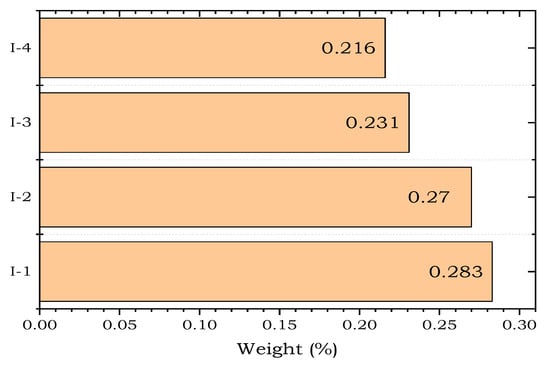
Figure 5.
The sub-factor results with respect to the information.
4.6. Weights of Sub-Factors (Service Quality)
Figure 6 shows the sub-factor weights with respect to the Service Quality criterion. It can be seen that the sub-criterion Trust (Q-1) received the highest weight of 33.2%. The sub-criterion Easy Returns (Q-4) got the second-highest weight of 30.6%. The On-time delivery (Q-3) and Payment Alternatives (Q-2) sub-factors obtained the second lowest and lowest weights of 22% and 14.2%, respectively.
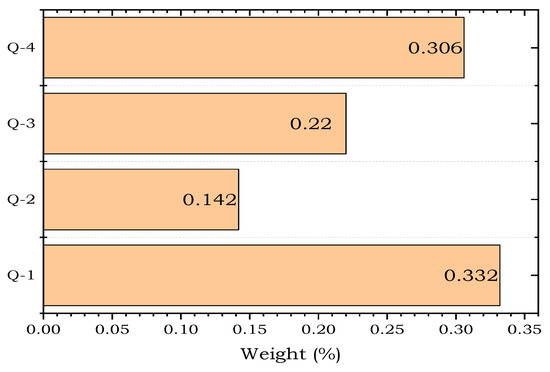
Figure 6.
The sub-factor results with respect to the service quality.
4.7. Weights of Sub-Factors (Security/Privacy)
Figure 7 displays the weights of the sub-factors with respect to the Security/Privacy criterion. The Secure Payment (S-2) sub-criterion achieved 51.6% of the weight, which is the highest weight received under the Security/Privacy criterion. The Account Security (S-1) sub-criterion received 30.9%, while Non-sharing personal information (S-3) got the lowest weight of 17.5%.
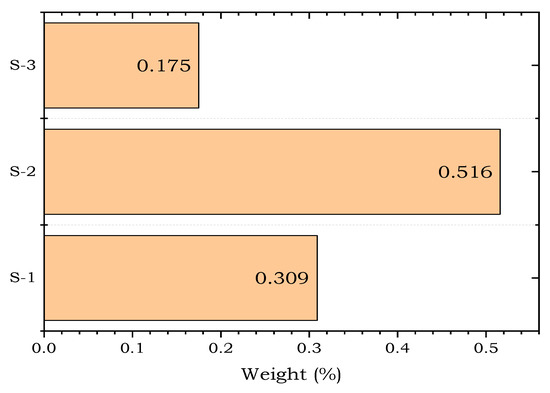
Figure 7.
The sub-factor results with respect to the security/privacy.
4.8. Weights of Sub-Factors (Customer Service & Support)
Figure 8 provides the weights of the sub-factors under the Customer Service & Support criterion. Order Tracking (C-2) received the highest weight of 38.6% under this criterion, followed respectively by Assisting in solving delivery issues (C-3) 33.1% and Feedback mechanism (C-1) 28.3%.
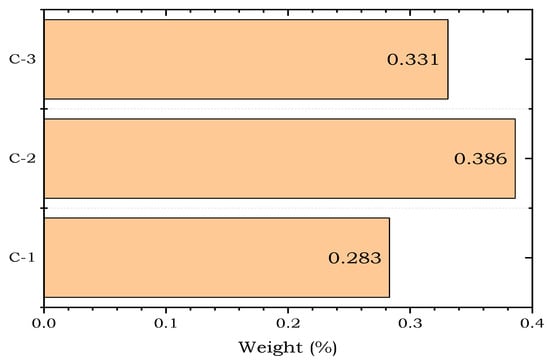
Figure 8.
The sub-factors result with respect to the Customer Service & Support.
4.9. Final Ranking of Overall Factors
After obtaining the main factor weights and sub-factor weights (with respect to the main criteria), we finally computed the final weights of sub-factors, which shall be employed in TOPSIS-Grey to rank the alternatives. The final weights of sub-factors were calculated by multiplying the initial weights of sub-factors with weights of their respective main factor. Table 6 lists the final weights of sub-factors and their overall ranking. The Secure payment (S-2) sub-factor ranked as the most important among the 19 sub-factors. In contrast, the Mobile-friendly (D-5) sub-factor was the least significant factor. A rationale behind the low ranking of the D-5 sub-factor is perhaps because people tend to use mobile apps instead of browsing online on shopping websites, and most of the famous online stores already have mobile apps for online shopping.

Table 6.
Final weights of overall B2C e-commerce factors.
4.10. TOPSIS-Grey Method
The integrated TOPSIS-Grey method was used to rank five B2C e-commerce websites based on five main factors (main-criteria) and 19 sub-factors (sub-criteria). During this phase, experts were asked to rate alternatives with respect to the sub-factors. To compile the experts’ feedback, a grey decision matrix was constructed which was later normalized. Table A7 and Table A8 in the Appendix B provide the grey decision and grey normalized matrices, respectively. Table A9 in the Appendix B shows the values of the positive ideal and negative ideal solutions. Table A10 and Table A11 contain the values of the positive ideal distance and negative ideal distance, respectively. Finally, the relative closeness of each alternative was obtained, and the alternatives were ranked according to their relative closeness values. Table 7 lists the relative closeness and a final ranking of websites. It can be seen that Website-3 received the highest relative closeness score (0.631), which translates that Website-3 is the most successful website among all the five websites analyzed in this study. Website-1 ranked second by obtaining a 0.622 relative closeness. Website-2 received the third-highest relative closeness value of 0.498, followed by Website-4, which received a second-lowest score of 0.44 and was ranked fourth. Website-5 got the least score (0.344), and thus it can be said that Website-5 has the lowest implementation of critical successful factors required for an effective B2C e-commerce website.

Table 7.
The relative closeness and a final ranking of B2C E-commerce websites (alternatives).
4.11. Sensitivity Analysis
A sensitivity analysis was performed to check if the results received using the integrated methodology are robust and reliable. To know the impact of changes in the criteria and sub-criteria weights on the final ranking of the website, we developed 6 more cases with different weights. In Case-2, all the main criteria were given equal weights (0.20 weight to each main criterion). For Case-3, we assigned a 0.40 weight to the design criteria, and the rest of each criterion was given 0.15. In Case-4, the Information criterion was given a 0.40 weight, and each of the others were given 0.15. In Cases-5, 6, and 7, service quality, security/privacy, and customer support center were respectively given a 0.40 weight, while the others were assigned 0.15. The subsequent changes in the final weights of the sub-criteria for all the seven cases are provided in Table 8. These different weights of the sub-criteria were used in the integrated TOPSIS-Grey methodology to check any variance in the final ranking. Figure 9 depicts the results of changes in weights on the final ranking. It can be seen that the final rankings remained the same in almost every case except Case-4 and Case-5, where the effect only changed the rankings of Website-1 and Website-3 while the others remained the same.

Table 8.
Different sub-criteria weights.
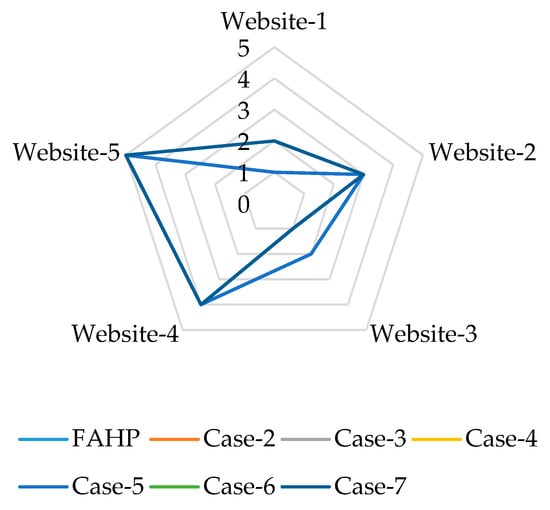
Figure 9.
Sensitivity analysis.
4.12. Discussion
In the present research, five B2C e-commerce websites of China were selected as a case analysis. Each of the websites was assessed based on proposed e-commerce website factors and sub-factors. In the study, an integrated decision methodology comprised of Fuzzy AHP and TOPSIS-Grey was applied to determine this decision problem. The Fuzzy AHP results showed that service quality (Q) is the favorite factor when implementing a B2C e-commerce website, followed by security/privacy (S), design (D), information (I), and customer service and support (C). The TOPSIS-Grey analysis presents that Website-3 is the most successful in running a B2C e-business because this website significantly follows crucial factors when compared to the other four websites. Website-1 was identified as the second most important B2C e-commerce website, followed by Website-2, Website-4, and Website-5.
This research is the very first that has identified and evaluated the B2C e-commerce factors and sub-factors based on the Fuzzy AHP and TOPSIS-Grey approach. However, there are many studies that are available in the existing literature that have evaluated websites by determining e-commerce factors with different goals and objectives. In the literature review section, the authors provided previous studies with their research findings. In these studies, the authors used different types of MCDM methods to significantly determine the decision problem. The AHP [21,23,50], TOPSIS [22,23,24], DEMATEL [25], and ANP [27] methods have been used for assessing the performance of e-commerce websites. In this study, we identified that none of the researchers utilized a Fuzzy AHP and TOPSIS-Grey model to assess the B2C e-commerce factors and sub-factors when assessing e-commerce websites in the context of China.
The proposed Fuzzy AHP and TOPSIS-Grey approach is validated through this case study for China. The determined e-commerce websites were evaluated in a fuzzy environment, and it was not easy to determine the problem since it had various uncertainties and vagueness. Therefore, this study utilized the Fuzzy AHP method to analyze the e-commerce factors and sub-factors, and the TOPSIS-Grey approach was used to evaluate the B2C e-commerce websites based on identified factors and sub-factors. This research could help the government and managers to determine this decision problem for the feasible performance of B2C e-commerce websites.
5. Conclusions
The evaluation of B2C e-commerce factors constitutes the crucial notion of the current research, and we applied integrated Fuzzy AHP and TOPSIS-Grey techniques, which have never been used in any previous studies before. This decision framework was further categorized into three sections. In the first section, a problem statement was observed and explained; for evaluating websites (alternatives), the B2C e-commerce websites were chosen, and we also identified successful assessment factors and sub-factors. In the second section, the Fuzzy AHP method was used to determine the B2C e-commerce factors and sub-factors using TFNs. Then, the TOPSIS-Grey method was utilized to assess the B2C e-commerce websites (alternatives) based on identified factors and sub-factors.
To implement the proposed methodology of the study, we highly recommend that one consider these factors for successfully designing a website on the e-commerce platform. Therefore, analysts are suggested to conduct further investigations regarding this decision problem. Moreover, it is essential to consider the main-factors’ and their sub-factors’ importance weight information. There are three leading potential areas of utility and contributions to this work. First, the previous studies on the assessment of B2C e-commerce websites only focused on a single or a hybrid MCDM method. However, this study suggested new integrated Fuzzy AHP and TOPSIS-Grey techniques. The strength of this decision-making approach is the fundamental idea of Fuzzy AHP, which provides meaningful and accurate explanations regarding the B2C e-commerce factors (and their sub-factors) of the hierarchical structure. Second, empirical work shows that TOPSIS-Grey was found to be an efficient and practical instrument of the B2C e-commerce websites’ ranking based on various factors. This technique has the potential to evaluate the performance of service sectors in relation to those with similar B2C e-commerce platform characteristics. Finally, the advantages of this technique are not just limited and applicable to B2C e-commerce websites’ evaluation but also enhance different specific operations and services via potential applications.
Although the proposed method offers numerous advantages and potentials, some limitations can lead to suggestions for future work. First, the current research did not consider the existing relationship with B2C e-commerce websites. Thus, we suggest that it be included for future work for better results. This study can be extended further by applying the Fuzzy DEMATEL technique to capture interrelationships graphically among defined criteria. Second, the proposed method would be useful for decision-making in other related areas.
In this study, we presented a Fuzzy AHP and TOPSIS-Grey methodology to evaluate B2C e-commerce factors for improving the website quality. In the study, the authors believe that an integrated decision model helps in minimizing the complexity and fuzziness of the decision problem. For future research directions, the results of this study could be compared with findings of other fuzzy MCDM approaches such as VIKOR, SAW, DEA, ANP, and PROMETHEE. Moreover, the proposed B2C e-commerce factors for designing the websites can be applied to other sectors like health, banking, music, and aviation.
Author Contributions
Conceptualization, R.L.; methodology, T.S.; software, T.S.; validation, R.L. and T.S.; formal analysis, R.L.; investigation, T.S.; data curation, R.L.; writing—original draft preparation, R.L.; writing—review and editing, T.S.; supervision, T.S. All authors have read and agreed to the published version of the manuscript.
Funding
This research received funding from outstanding young backbone teachers of the “Blue Project” in the Department of Education, Jiangsu Province, 2019.
Conflicts of Interest
The authors declare no conflict of interest.
Appendix A. Results of Fuzzy AHP

Table A1.
Main-factors Pairwise matrix.
Table A1.
Main-factors Pairwise matrix.
| Design (D) | Information (I) | Service Quality (Q) | Security/Privacy (S) | Customer Service and Support (C) | |
|---|---|---|---|---|---|
| Design (D) | 1, 1, 1 | 0.874, 1.236, 1.693 | 0.46, 0.616, 0.871 | 0.558, 0.752, 1.027 | 0.791, 1.105, 1.551 |
| Information (I) | 0.591, 0.809, 1.144 | 1, 1, 1 | 0.473, 0.645, 0.912 | 0.503, 0.657, 0.894 | 0.813, 1.18, 1.637 |
| Service Quality (Q) | 1.149, 1.624, 2.173 | 1.097, 1.551, 2.115 | 1, 1, 1 | 0.785, 1.076, 1.463 | 1.163, 1.551, 2.013 |
| Security/Privacy (S) | 0.973, 1.33, 1.792 | 1.118, 1.521, 1.989 | 0.684, 0.929, 1.273 | 1, 1, 1 | 1.218, 1.726, 2.296 |
| Customer service and support (C) | 0.645, 0.905, 1.264 | 0.611, 0.847, 1.231 | 0.497, 0.645, 0.86 | 0.436, 0.579, 0.821 | 1, 1, 1 |
| CR = 0.0026 (Consistent) | |||||

Table A2.
Pairwise matrix of Sub-factor (Design).
Table A2.
Pairwise matrix of Sub-factor (Design).
| D-1 | D-2 | D-3 | D-4 | D-5 | |
|---|---|---|---|---|---|
| D-1 | 1, 1, 1 | 0.874, 1.236, 1.693 | 0.985, 1.366, 1.826 | 0.816, 1.097, 1.467 | 0.791, 1.105, 1.551 |
| D-2 | 0.591, 0.809, 1.144 | 1, 1, 1 | 0.591, 0.809, 1.144 | 0.503, 0.657, 0.894 | 0.813, 1.18, 1.637 |
| D-3 | 0.547, 0.732, 1.015 | 0.874, 1.236, 1.693 | 1, 1, 1 | 0.785, 1.076, 1.463 | 1.163, 1.551, 2.013 |
| D-4 | 0.681, 0.912, 1.225 | 1.118, 1.521, 1.989 | 0.684, 0.929, 1.273 | 1, 1, 1 | 0.985, 1.393, 1.857 |
| D-5 | 0.645, 0.905, 1.264 | 0.611, 0.847, 1.231 | 0.497, 0.645, 0.86 | 0.538, 0.718, 1.015 | 1, 1, 1 |
| CR = 0.0096 (Consistent) | |||||

Table A3.
Pairwise matrix of Sub-factor (Information).
Table A3.
Pairwise matrix of Sub-factor (Information).
| I-1 | I-2 | I-3 | I-4 | |
|---|---|---|---|---|
| I-1 | 1, 1, 1 | 0.741, 0.988, 1.35 | 1.055, 1.499, 2.044 | 0.858, 1.149, 1.503 |
| I-2 | 0.741, 1.012, 1.35 | 1, 1, 1 | 0.858, 1.149, 1.503 | 0.898, 1.236, 1.648 |
| I-3 | 0.489, 0.667, 0.948 | 0.665, 0.871, 1.166 | 1, 1, 1 | 0.912, 1.26, 1.678 |
| I-4 | 0.665, 0.871, 1.166 | 0.607, 0.809, 1.113 | 0.596, 0.794, 1.097 | 1, 1, 1 |
| CR =0.0093 (Consistent) | ||||

Table A4.
Pairwise matrix of Sub-factor (Service Quality).
Table A4.
Pairwise matrix of Sub-factor (Service Quality).
| Q-1 | Q-2 | Q-3 | Q-4 | |
|---|---|---|---|---|
| Q-1 | 1, 1, 1 | 2.319, 3.033, 3.852 | 1.055, 1.499, 2.044 | 0.611, 0.858, 1.231 |
| Q-2 | 0.26, 0.33, 0.431 | 1, 1, 1 | 0.596, 0.794, 1.097 | 0.356, 0.471, 0.66 |
| Q-3 | 0.489, 0.667, 0.948 | 0.912, 1.26, 1.678 | 1, 1, 1 | 0.665, 0.871, 1.166 |
| Q-4 | 0.813, 1.166, 1.637 | 1.514, 2.124, 2.812 | 0.858, 1.149, 1.503 | 1, 1, 1 |
| CR = 0.0213 (Consistent) | ||||

Table A5.
Pairwise matrix of Sub-factor (Security/Privacy).
Table A5.
Pairwise matrix of Sub-factor (Security/Privacy).
| S-1 | S-2 | S-3 | |
|---|---|---|---|
| S-1 | 1, 1, 1 | 0.422, 0.558, 0.747 | 1.446, 1.908, 2.465 |
| S-2 | 1.339, 1.792, 2.372 | 1, 1, 1 | 2.058, 2.79, 3.608 |
| S-3 | 0.406, 0.524, 0.692 | 0.277, 0.358, 0.486 | 1, 1, 1 |
| CR = 0.0047 (Consistent) | |||

Table A6.
Pairwise matrix of Sub-factor (Customer Service & Support).
Table A6.
Pairwise matrix of Sub-factor (Customer Service & Support).
| C-1 | C-2 | C-3 | |
|---|---|---|---|
| C-1 | 1, 1, 1 | 0.569, 0.782, 1.076 | 0.608, 0.787, 1.051 |
| C-2 | 0.929, 1.279, 1.758 | 1, 1, 1 | 0.938, 1.255, 1.629 |
| C-3 | 0.952, 1.27, 1.646 | 0.614, 0.797, 1.066 | 1, 1, 1 |
| CR = 0.0055 (Consistent) | |||
Appendix B. Results of TOPSIS-Grey

Table A7.
Decision matrix.
Table A7.
Decision matrix.
| D-1 | D-2 | D-3 | D-4 | D-5 | I-1 | I-2 | I-3 | I-4 | Q-1 | Q-2 | Q-3 | Q-4 | S-1 | S-2 | S-3 | C-1 | C-2 | C-3 | |
|---|---|---|---|---|---|---|---|---|---|---|---|---|---|---|---|---|---|---|---|
| W-1 | 4.5, 6.2 | 4.9, 6.5 | 3, 4.2 | 5.9, 7.3 | 3.7, 5 | 4.1, 5.2 | 4.8, 6.2 | 4.7, 6.1 | 4.2, 5.5 | 4.2, 5.6 | 2.9, 4.2 | 3.8, 5.2 | 4.1, 5.4 | 6, 7.7 | 4.2, 5.3 | 4.4, 5.5 | 5, 6.4 | 4.5, 6.1 | 4.3, 5.5 |
| W-2 | 4.5, 5.8 | 4.8, 6.4 | 2.8, 3.9 | 5, 6.4 | 3.5, 4.8 | 3.6, 4.8 | 4.9, 6.1 | 4.5, 5.8 | 3.7, 5 | 3.7, 5.2 | 3.1, 4.2 | 2.8, 4.2 | 3.9, 5.5 | 5.3, 6.8 | 3.6, 4.6 | 4.4, 6 | 4.6, 6.1 | 4.5, 5.6 | 3.5, 4.8 |
| W-3 | 4.5, 6.3 | 4.9, 6.5 | 3.4, 4.6 | 5.2, 6.6 | 4.3, 5.7 | 3.6, 5 | 4.9, 6.3 | 4.6, 6.2 | 3.9, 5.2 | 3.9, 5.5 | 3, 4.2 | 3.7, 5 | 3.9, 5.4 | 6, 7.9 | 4.5, 5.9 | 4.5, 5.8 | 5.2, 6.5 | 5, 6.5 | 4.4, 5.6 |
| W-4 | 4.4, 5.7 | 4.5, 5.9 | 2.1, 3.5 | 4.4, 5.7 | 3.1, 4.5 | 2.5, 4 | 4.2, 5.6 | 3.9, 5.4 | 3.5, 4.6 | 3.1, 4.6 | 2.9, 4.2 | 3, 4.3 | 3.5, 4.8 | 5.7, 7.3 | 4, 5.3 | 4, 5.3 | 3.9, 5.5 | 4.5, 6 | 3.6, 5.2 |
| W-5 | 4, 5.3 | 4.1, 5.4 | 1.6, 3.1 | 3.9, 5 | 2.7, 4 | 2.2, 3.5 | 4.2, 5.5 | 3.5, 4.9 | 3.6, 5 | 2.8, 4 | 2.6, 4 | 3.1, 4.3 | 3.5, 4.8 | 5.1, 6.8 | 3, 4.4 | 3.7, 5.3 | 3.5, 4.9 | 4.4, 5.8 | 3.7, 5 |

Table A8.
Normalized matrix.
Table A8.
Normalized matrix.
| D-1 | D-2 | D-3 | D-4 | D-5 | I-1 | I-2 | I-3 | I-4 | Q-1 | Q-2 | Q-3 | Q-4 | S-1 | S-2 | S-3 | C-1 | C-2 | C-3 | |
|---|---|---|---|---|---|---|---|---|---|---|---|---|---|---|---|---|---|---|---|
| W-1 | 0.7, 1 | 0.8, 1 | 0.6, 0.9 | 0.8, 1 | 0.7, 0.9 | 0.8, 1 | 0.8, 1 | 0.8, 1 | 0.8, 1 | 0.7, 1 | 0.7, 1 | 0.7, 1 | 0.8, 1 | 0.8, 1 | 0.7, 0.9 | 0.1, 0.3 | 0.8, 1 | 0.7, 0.9 | 0.8, 1 |
| W-2 | 0.7, 0.9 | 0.7, 1 | 0.6, 0.8 | 0.7, 0.9 | 0.6, 0.8 | 0.7, 0.9 | 0.8, 1 | 0.7, 0.9 | 0.7, 0.9 | 0.7, 0.9 | 0.7, 1 | 0.5, 0.8 | 0.7, 1 | 0.7, 0.9 | 0.6, 0.8 | 0, 0.3 | 0.7, 0.9 | 0.7, 0.9 | 0.6, 0.9 |
| W-3 | 0.7, 1 | 0.8, 1 | 0.7, 1 | 0.7, 0.9 | 0.7, 1 | 0.7, 1 | 0.8, 1 | 0.8, 1 | 0.7, 1 | 0.7, 1 | 0.7, 1 | 0.7, 1 | 0.7, 1 | 0.8, 1 | 0.8, 1 | 0, 0.3 | 0.8, 1 | 0.8, 1 | 0.8, 1 |
| W-4 | 0.7, 0.9 | 0.7, 0.9 | 0.5, 0.7 | 0.6, 0.8 | 0.5, 0.8 | 0.5, 0.8 | 0.7, 0.9 | 0.6, 0.9 | 0.7, 0.9 | 0.5, 0.8 | 0.7, 1 | 0.6, 0.8 | 0.6, 0.9 | 0.7, 0.9 | 0.7, 0.9 | 0.1, 0.3 | 0.6, 0.8 | 0.7, 0.9 | 0.6, 0.9 |
| W-5 | 0.6, 0.8 | 0.6, 0.8 | 0.4, 0.7 | 0.5, 0.7 | 0.5, 0.7 | 0.4, 0.7 | 0.7, 0.9 | 0.6, 0.8 | 0.7, 0.9 | 0.5, 0.7 | 0.6, 1 | 0.6, 0.8 | 0.7, 0.9 | 0.6, 0.9 | 0.5, 0.7 | 0.1, 0.4 | 0.5, 0.8 | 0.7, 0.9 | 0.7, 0.9 |

Table A9.
Positive ideal alternativeand negative ideal alternative.
Table A9.
Positive ideal alternativeand negative ideal alternative.
| D-1 | D-2 | D-3 | D-4 | D-5 | I-1 | I-2 | I-3 | I-4 | Q-1 | Q-2 | Q-3 | Q-4 | S-1 | S-2 | S-3 | C-1 | C-2 | C-3 | |
|---|---|---|---|---|---|---|---|---|---|---|---|---|---|---|---|---|---|---|---|
| 1 | 1 | 1 | 1 | 1 | 1 | 1 | 1 | 1 | 1 | 1 | 1 | 1 | 1 | 1 | 0 | 1 | 1 | 1 | |
| 0.638 | 0.625 | 0.353 | 0.538 | 0.476 | 0.421 | 0.667 | 0.574 | 0.65 | 0.5 | 0.63 | 0.544 | 0.633 | 0.644 | 0.508 | 0.379 | 0.542 | 0.667 | 0.629 |

Table A10.
Alternatives’ positive ideal solution distance.
Table A10.
Alternatives’ positive ideal solution distance.
| D-1 | D-2 | D-3 | D-4 | D-5 | I-1 | I-2 | I-3 | I-4 | Q-1 | Q-2 | Q-3 | Q-4 | S-1 | S-2 | S-3 | C-1 | C-2 | C-3 | ||
|---|---|---|---|---|---|---|---|---|---|---|---|---|---|---|---|---|---|---|---|---|
| Website-1 | 0.003 | 0.002 | 0.005 | 0.001 | 0.004 | 0.002 | 0.002 | 0.002 | 0.002 | 0.006 | 0.003 | 0.004 | 0.005 | 0.004 | 0.012 | 0.004 | 0.002 | 0.006 | 0.003 | 0.19 |
| Website-2 | 0.004 | 0.002 | 0.007 | 0.005 | 0.005 | 0.004 | 0.002 | 0.003 | 0.004 | 0.01 | 0.003 | 0.014 | 0.006 | 0.01 | 0.025 | 0.007 | 0.004 | 0.007 | 0.008 | 0.255 |
| Website-3 | 0.003 | 0.002 | 0.003 | 0.004 | 0.002 | 0.004 | 0.002 | 0.002 | 0.003 | 0.008 | 0.003 | 0.005 | 0.006 | 0.004 | 0.007 | 0.006 | 0.002 | 0.003 | 0.003 | 0.19 |
| Website-4 | 0.004 | 0.003 | 0.014 | 0.008 | 0.008 | 0.014 | 0.005 | 0.006 | 0.005 | 0.02 | 0.003 | 0.012 | 0.012 | 0.006 | 0.015 | 0.003 | 0.008 | 0.006 | 0.007 | 0.282 |
| Website-5 | 0.006 | 0.005 | 0.02 | 0.012 | 0.011 | 0.021 | 0.006 | 0.009 | 0.004 | 0.029 | 0.005 | 0.011 | 0.011 | 0.011 | 0.039 | 0.003 | 0.012 | 0.007 | 0.007 | 0.338 |

Table A11.
Alternatives’ negative ideal solution distance.
Table A11.
Alternatives’ negative ideal solution distance.
| D-1 | D-2 | D-3 | D-4 | D-5 | I-1 | I-2 | I-3 | I-4 | Q-1 | Q-2 | Q-3 | Q-4 | S-1 | S-2 | S-3 | C-1 | C-2 | C-3 | ||
|---|---|---|---|---|---|---|---|---|---|---|---|---|---|---|---|---|---|---|---|---|
| Website-1 | 0.005 | 0.005 | 0.015 | 0.012 | 0.005 | 0.022 | 0.005 | 0.008 | 0.005 | 0.027 | 0.005 | 0.014 | 0.011 | 0.009 | 0.024 | 0.003 | 0.01 | 0.004 | 0.007 | 0.313 |
| Website-2 | 0.004 | 0.004 | 0.012 | 0.005 | 0.004 | 0.016 | 0.005 | 0.006 | 0.003 | 0.017 | 0.006 | 0.004 | 0.011 | 0.004 | 0.011 | 0.003 | 0.008 | 0.002 | 0.003 | 0.253 |
| Website-3 | 0.006 | 0.005 | 0.021 | 0.007 | 0.01 | 0.017 | 0.005 | 0.008 | 0.003 | 0.022 | 0.005 | 0.012 | 0.01 | 0.011 | 0.039 | 0.003 | 0.012 | 0.007 | 0.008 | 0.325 |
| Website-4 | 0.003 | 0.003 | 0.006 | 0.003 | 0.003 | 0.006 | 0.002 | 0.003 | 0.001 | 0.009 | 0.005 | 0.005 | 0.005 | 0.006 | 0.022 | 0.005 | 0.004 | 0.004 | 0.004 | 0.222 |
| Website-5 | 0.002 | 0.001 | 0.004 | 0.001 | 0.001 | 0.003 | 0.002 | 0.002 | 0.003 | 0.004 | 0.004 | 0.005 | 0.005 | 0.004 | 0.007 | 0.007 | 0.002 | 0.003 | 0.003 | 0.177 |
References
- Hoffman, D.L.; Novak, T.P. A New Marketing Paradigm for Electronic Commerce. Inf. Soc. 1997, 13, 43–54. [Google Scholar]
- E-Commerce and E-Business. In Information and Communication Technology in Organizations: Adoption, Implementation, Use and Effects; Sage Publications: London, UK, 2012; pp. 139–162.
- Oliveira, T.; Alhinho, M.; Rita, P.; Dhillon, G. Modelling and Testing Consumer Trust Dimensions in E-Commerce. Comput. Human Behav. 2017, 71, 153–164. [Google Scholar] [CrossRef]
- Shaw, M.J. Electronic Commerce: State of the Art. In Handbook on Electronic Commerce; Springer: Berlin/Heidelberg, Germany, 2000; pp. 3–24. [Google Scholar]
- Bhasin, H. Top E-Commerce Companies in the World; Marketing91: Mumbai, India, 2019. [Google Scholar]
- Gurung, A.; Raja, M.K. Online Privacy and Security Concerns of Consumers. Inf. Comput. Secur. 2016, 24, 348–371. [Google Scholar] [CrossRef]
- Chiu, W.Y.; Tzeng, G.H.; Li, H.L. Developing E-Store Marketing Strategies to Satisfy Customers’ Needs Using a New Hybrid Gray Relational Model. Int. J. Inf. Technol. Decis. Mak. 2014, 13, 231–261. [Google Scholar] [CrossRef]
- Zhang, Y.; Deng, X.; Wei, D.; Deng, Y. Assessment of E-Commerce Security Using AHP and Evidential Reasoning. Expert Syst. Appl. 2012, 39, 3611–3623. [Google Scholar] [CrossRef]
- Abdullah, L.; Ramli, R.; Bakodah, H.O.; Othman, M. Developing a Causal Relationship among Factors of E-Commerce: A Decision Making Approach. J. King Saud Univ.-Comput. Inf. Sci. 2019, in press. [Google Scholar] [CrossRef]
- Yu, X.; Guo, S.; Guo, J.; Huang, X. Rank B2C E-Commerce Websites in e-Alliance Based on AHP and Fuzzy TOPSIS. Expert Syst. Appl. 2011, 38, 3550–3557. [Google Scholar] [CrossRef]
- Jurado, E.B.; Moral, A.M.; Viruel, M.J.M.; Uclés, D.F. Evaluation of Corporate Websites and Their Influence on the Performance of Olive Oil Companies. Sustainability 2018, 10, 1274. [Google Scholar] [CrossRef]
- Ostovare, M.; Shahraki, M.R. Evaluation of Hotel Websites Using the Multicriteria Analysis of PROMETHEE and GAIA: Evidence from the Five-Star Hotels of Mashhad. Tour. Manag. Perspect. 2019, 30, 107–116. [Google Scholar] [CrossRef]
- Aydin, S.; Kahraman, C. Evaluation of E-Commerce Website Quality Using Fuzzy Multi-Criteria Decision Making Approach. IAENG Int. J. Comput. Sci. 2012, 39, 64–70. [Google Scholar]
- Ziemba, P. Towards Strong Sustainability Management-a Generalized PROSA Method. Sustainability 2019, 11, 1555. [Google Scholar] [CrossRef]
- Nisar, T.M.; Prabhakar, G. What Factors Determine E-Satisfaction and Consumer Spending in e-Commerce Retailing? J. Retail. Consum. Serv. 2017, 39, 135–144. [Google Scholar] [CrossRef]
- Lin, Y.; Luo, J.; Cai, S.; Ma, S.; Rong, K. Exploring the Service Quality in the E-Commerce Context: A Triadic View. Ind. Manag. Data Syst. 2016, 116, 388–415. [Google Scholar] [CrossRef]
- Zameer, H.; Wang, Y.; Yasmeen, H. Reinforcing Green Competitive Advantage through Green Production, Creativity and Green Brand Image: Implications for Cleaner Production in China. J. Clean. Prod. 2020, 247, 119119. [Google Scholar] [CrossRef]
- Chesher, M.; Kaura, R. Introduction to Electronic Commerce; Springer: London, UK, 1998; pp. 69–87. [Google Scholar]
- Liang, T.P.; Turban, E. Introduction to the Special Issue Social Commerce: A Research Framework for Social Commerce. Int. J. Electron. Commer. 2011, 16, 5–13. [Google Scholar] [CrossRef]
- Mardani, A.; Jusoh, A.; Zavadskas, E.K. Fuzzy Multiple Criteria Decision-Making Techniques and Applications—Two Decades Review from 1994 to 2014. Expert Syst. Appl. 2015, 42, 4126–4148. [Google Scholar] [CrossRef]
- Rouyendegh, B.D.; Topuz, K.; Dag, A.; Oztekin, A. An AHP-IFT Integrated Model for Performance Evaluation of E-Commerce Web Sites. Inf. Syst. Front. 2019, 21, 1345–1355. [Google Scholar] [CrossRef]
- Özkan, B.; Özceylan, E.; Kabak, M.; Dağdeviren, M. Evaluating the Websites of Academic Departments through SEO Criteria: A Hesitant Fuzzy Linguistic MCDM Approach. Artif. Intell. Rev. 2020, 53, 875–905. [Google Scholar] [CrossRef]
- Kabassi, K. Evaluating Museum Websites Using a Combination of Decision-Making Theories. J. Herit. Tour. 2019, 14, 544–560. [Google Scholar] [CrossRef]
- Kaya, T. Multi-Attribute Evaluation of Website Quality in e-Business Using an Integrated Fuzzy AHPTOPSIS Methodology. Int. J. Comput. Intell. Syst. 2010, 3, 301–314. [Google Scholar] [CrossRef]
- Liang, R.; Wang, J.; Zhang, H. Evaluation of E-Commerce Websites: An Integrated Approach under a Single-Valued Trapezoidal Neutrosophic Environment. Knowl. -Based Syst. 2017, 135, 44–59. [Google Scholar] [CrossRef]
- Aggarwal, A.G.; Aakash, N.A. Multi-Criteria-Based Prioritisation of B2C e-Commerce Website. Int. J. Soc. Syst. Sci. 2018, 10, 201. [Google Scholar] [CrossRef]
- Chiu, W.Y.; Tzeng, G.H.; Li, H.L. A New Hybrid MCDM Model Combining DANP with VIKOR to Improve E-Store Business. Knowl. -Based Syst. 2013, 37, 48–61. [Google Scholar] [CrossRef]
- Makki, E.; Chang, L.-C. Understanding the Effects of Social Media and Mobile Usage on E-Commerce: An Exploratory Study in Saudi Arabia. Int. Manag. Rev. 2015, 11, 98. [Google Scholar]
- Bezhovski, Z. The Future of the Mobile Payment as Electronic Payment System, European Journal of Business and Management. Eur. J. Bus. Manag. 2016, 8, 127–132. [Google Scholar]
- Zhou, L.; Wang, W.; Xu, J.; Liu, T.; Gu, J. Perceived Information Transparency in B2C E-Commerce: An Empirical Investigation. Inf. Manag. 2018, 55, 912–927. [Google Scholar] [CrossRef]
- Ilbahar, E.; Cebi, S. Classification of Design Parameters for E-Commerce Websites: A Novel Fuzzy Kano Approach. Telemat. Inform. 2017, 8, 34. [Google Scholar] [CrossRef]
- Muneer, A.; Samreen, R.; Zaineb, F. Data Privacy Issues and Possible Solutions in E-Commerce. J. Account. Mark. 2018, 3, 7. [Google Scholar] [CrossRef]
- Thepsuparungsikul, W.; Rattanawicha, P. A Study of E-Service Applications in e-Commerce Websites. In Proceedings of the International Conference on Electronic Business (ICEB), Bangkok, Thailand, 29 November–2 December 2011; pp. 279–284. [Google Scholar]
- Halaweh, M. Implementation of the COD Payment Method on E-Commerce Websites in the Arab Region. Int. J. Bus. Inf. Syst. 2019, 32, 145–160. [Google Scholar]
- Leung, K.H.; Choy, K.L.; Siu, P.K.Y.; Ho, G.T.S.; Lam, H.Y.; Lee, C.K.M. A B2C E-Commerce Intelligent System for Re-Engineering the e-Order Fulfilment Process. Expert Syst. Appl. 2018, 91, 386–401. [Google Scholar] [CrossRef]
- Ong, C.E.; Teh, D. Redress Procedures Expected by Consumers during a Business-to-Consumer e-Commerce Dispute. Electron. Commer. Res. Appl. 2016, 17, 150–160. [Google Scholar] [CrossRef]
- Lin, H.F. The Impact of Website Quality Dimensions on Customer Satisfaction in the B2C E-Commerce Context. Total Qual. Manag. Bus. Excell. 2007, 18, 363–378. [Google Scholar] [CrossRef]
- Abedi, F.; Zeleznikow, J.; Bellucci, E. Universal Standards for the Concept of Trust in Online Dispute Resolution Systems in E-Commerce Disputes. Int. J. Law Inf. Technol. 2019, 27, 209–237. [Google Scholar] [CrossRef]
- Xu, L.; Shah, S.A.A.; Zameer, H.; Solangi, Y.A. Evaluating Renewable Energy Sources for Implementing the Hydrogen Economy in Pakistan: A Two-Stage Fuzzy MCDM Approach. Environ. Sci. Pollut. Res. 2019, 26, 33202–33215. [Google Scholar] [CrossRef]
- Shah, S.A.A.; Solangi, Y.A.; Ikram, M. Analysis of Barriers to the Adoption of Cleaner Energy Technologies in Pakistan Using Modified Delphi and Fuzzy Analytical Hierarchy Process. J. Clean. Prod. 2019, 235, 1037–1050. [Google Scholar] [CrossRef]
- Solangi, Y.A.; Shah, S.A.A.; Zameer, H.; Ikram, M.; Saracoglu, B.O. Assessing the Solar PV Power Project Site Selection in Pakistan: Based on AHP-Fuzzy VIKOR Approach. Environ. Sci. Pollut. Res. 2019, 26, 30286–30302. [Google Scholar] [CrossRef]
- Wang, Y.; Xu, L.; Solangi, Y.A. Strategic Renewable Energy Resources Selection for Pakistan: Based on SWOT-Fuzzy AHP Approach. Sustain. Cities Soc. 2020, 52, 101861. [Google Scholar] [CrossRef]
- Shah, S.A.A. Feasibility Study of Renewable Energy Sources for Developing the Hydrogen Economy in Pakistan. Int. J. Hydrog. Energy 2019, in press. [Google Scholar] [CrossRef]
- Tzeng, G.H.; Huang, J.J. Multiple Attribute Decision Making: Methods and Applications; Taylor and Francis: New York, NK, USA, 2011; pp. 1–333. [Google Scholar]
- Wang, X.; Zameer, S.; Siyal, S.W. Economic Viability and Environmental Efficiency Analysis of Hydrogen Production Processes for the Decarbonization of Energy Systems. Processes 2019, 7, 494. [Google Scholar]
- Solangi, Y.A.; Tan, Q.; Mirjat, N.H.; Valasai, G.D.; Khan, M.W.A.; Ikram, M. An Integrated Delphi-AHP and Fuzzy TOPSIS Approach toward Ranking and Selection of Renewable Energy Resources in Pakistan. Processes 2019, 7, 118. [Google Scholar] [CrossRef]
- Zavadskas, E.K.; Vilutienė, T.; Turskis, Z.; Tamosaitienė, J. Contractor Selection for Construction Works by Applying Saw-G and Topsis Grey Techniques. J. Bus. Econ. Manag. 2010, 11, 34–55. [Google Scholar] [CrossRef]
- Deng, J. Introduction to Grey System. J. Grey Syst. 1989, 1, 1–24. [Google Scholar]
- Oztaysi, B. A Decision Model for Information Technology Selection Using AHP Integrated TOPSIS-Grey: The Case of Content Management Systems. Knowl. -Based Syst. 2014, 70, 44–54. [Google Scholar] [CrossRef]
- Musaad, O.; Sultan, A.; Zhuo, Z.; Musaad, O.; Otaibi, A.; Siyal, Z.A.; Hashmi, H.; Shah, S.A.A. A Fuzzy Multi-Criteria Analysis of Barriers and Policy Strategies for Small and Medium Enterprises to Adopt Green Innovation. Symmetry 2020, 12, 116. [Google Scholar] [CrossRef]
© 2020 by the authors. Licensee MDPI, Basel, Switzerland. This article is an open access article distributed under the terms and conditions of the Creative Commons Attribution (CC BY) license (http://creativecommons.org/licenses/by/4.0/).